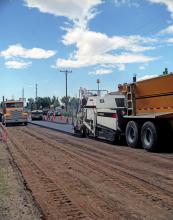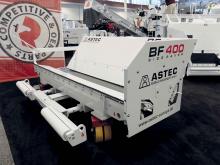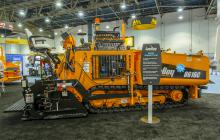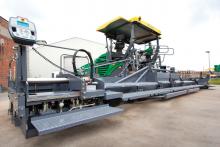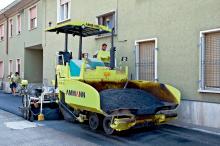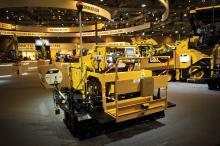US style high production pavers are seeing key performance gains - Mike Woof reports. Exhaust emissions regulations and ever tougher safety requirements have pushed manufacturers to develop new and improved pavers aimed at the US market. The rivalry between manufacturers of these machines has also intensified. European manufacturers have developed their own US style pavers in recent years. BOMAG, Dynapac and Vögele have all designed machines using the benefit of their US engineering input in a bid to target
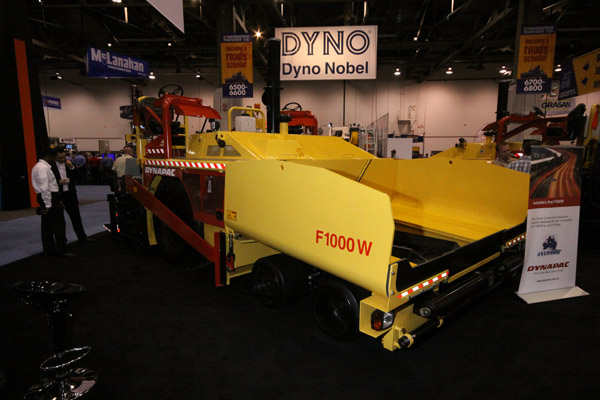
The latest US style Dynapac pavers are designed to maximise visibility across the hopper
US style high production pavers are seeing key performance gains - Mike Woof reports
Exhaust emissions regulations and ever tougher safety requirements have pushed manufacturers to develop new and improved pavers aimed at the US market. The rivalry between manufacturers of these machines has also intensified. European manufacturers have developed their own US style pavers in recent years.Market demand for new pavers is not strong in North America at present and in the face of these tough conditions, perhaps the best growth areas for the US style paver are in Latin America and Australia. While Brazil is benefiting from major investment in its road network, the country's tough import duties make it difficult to bring in machines. Other countries in Latin America seeing highway expansion, Colombia in particular (although Bolivia, Chile and Peru are also investing in infrastructure), present better sales opportunities for manufacturers of US style pavers. Australia represents an unusual market for pavers though, one of the few in the world where both US and European style machines are used.
Interestingly while the Chinese authorities have chosen to emulate the US Interstate network, Chinese contractors have largely opted to use European style paving machines to carry out the asphalt surfacing work.
The
Dynapac has been the latest of the European firms to develop a new line of North American style asphalt pavers, with its latest F1000 series tracked and wheeled machines. As with its main European rivals Dynapac has opted to design and build these units in the US and with the benefit of US know-how of the market needs. The tracked F1000T and wheeled F1000W asphalt pavers have been built to handle extreme conditions in remote locations, allowing them to operate reliably in tough working environments. The machines are simple in design and are able to run at altitudes of over 3,000m and at temperatures of up to 38°C, while they are also said to be easy to maintain, service and repair in the field.
In case of a problem, the design is said to ensure speedy identification of technical issues, which operators can address quickly and minimise downtime. This last is an important point, especially when operating at a remote site, as downtime can be a major cost burden to contractors. Improved visibility is another important feature and the firm has ensured that the pavers have a low deck profile. The pavers can deliver 540tonnes/hour of asphalt to lay 305mm or thin overlays on rehabilitation projects. Ensuring the pavers provide good mat quality was another important design parameter. The pavers benefit from a proven auger already used on the firm's European machines that does away with the need for a centre drive box. This auger configuration is said to eliminate the problem of material segregation in the mat by allowing a more even flow of asphalt across the width of the screed.
LB Performance, a division of VT LeeBoy, now offers the Blaw-Knox branded RW-80A road widener. This latest model to the line-up shares the same design platforms associated with the company's larger RW-100B and RW195E. The RW-80A can place both aggregate and bituminous materials for applications including new construction and maintenance or repair work. It comes with a 60kW
A hydraulically adjustable hopper lip reduces spillage during the dump cycle and accommodates varying truck bed heights. For versatility, the RW-80A's conveyor system can discharge material from either side of the machine. The operator control console can be slid to either side of the deck while other features allow simplified cleaning and maintenance procedures.
LeeBoy has licensed the Blaw-Knox paver brand from Volvo Construction Equipment and will be responsible for all engineering, design, manufacturing, marketing and support of the products. The range consists of four road wideners and two rubber-tyred pavers, all of which are Cummins-powered with the exception of the smallest paver as it has a
John Irvine is vice-president in charge of sales and marketing at Roadtec and he says that the firm is now offering machines that meet the Tier 4 Interim emissions requirements.
The new RP195E is the latest version of the firm's 3m highway class tracked paver, with the E denoting its new low emission engine.
Despite the extra cooling requirements of the diesel, the firm has taken care to optimise the overall machine design. He said, "It has improved visibility and maintenance access." In other respects the RP195E shares features with the model it replaces, such as its high manoeuvrability and the rubber track design.
Although Vögele has offered its US style Vision pavers since 2008, the firm has specifically designed a new screed for use in the North American market. The VR600-2 is a rear-mounted screed with basic paving width of 3.05m, extendible to 8.5m. The primary feature for the North American market is the inclusion of slope control, with a hydraulic extension slope control up to 10%. The new screed is also designed to simplify paving sloped pavement profiles. When sloping the extensions, only the frame of the screed extension is sloped, leaving the guide system horizontal at all times, providing maximum rigidity from the screed. Another major feature is the inclusion of Vögele's ErgoPlus screed control system, which is said to be both easy and intuitive to operate. As the ErgoPlus control is standard across the firm's paver range, this allows operators to switch between using any machine in the firm's line-up with minimal familiarisation.

